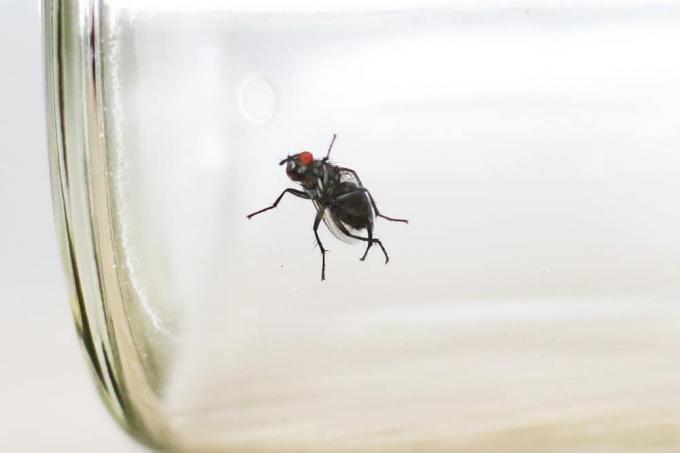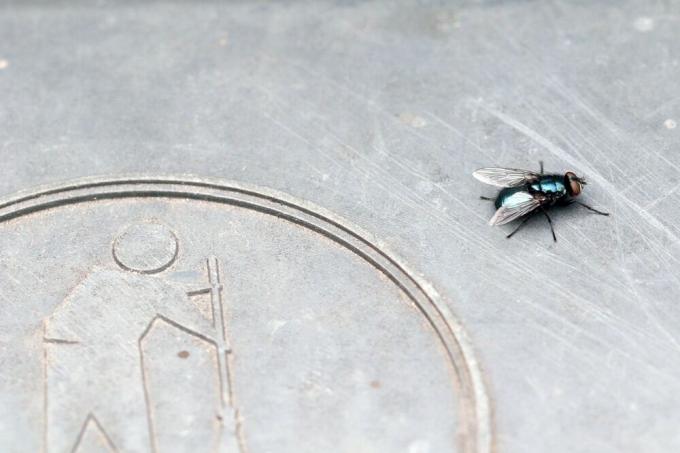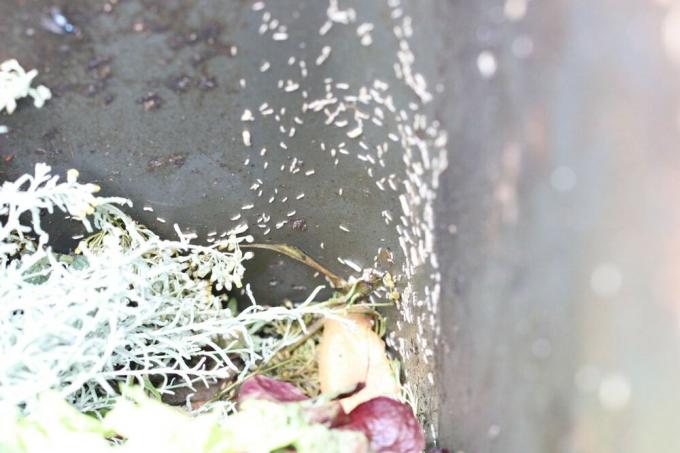

Table of contents
- What are maggots and how do they get into the apartment?
- Real fly, e.g. B. houseflies
- flesh flies
- fruit flies
- blowflies
- Cleaning away maggots - but right
- New maggots? look for stove!
- Worms, larvae or maggots?
- Fight maggots and flies
- fight flies?
- Tenant rights in case of maggot infestation
The mind says: A few cells of protein, newly born = harmless. The feeling says: snakes, worms = get rid of the stuff, IMMEDIATELY! Putting the stuff away isn't a problem; even proven snake phobics dare to approach tiny maggots in the protection of the cleaning kit. The problem can be that new maggots appear after cleaning away, the article will guide you on the trail of this recurring nuisance. You will also learn how to get rid of maggots forever or how to get rid of them. Prevent "increased maggot occurrence" in the future:
What are maggots and how do they get into the apartment?
Maggots are the children of flies, which are applied directly to the home in the form of eggs. There are a few hundred eggs, and small, white maggots crawl out of all these eggs. Animal food is typical, but female flies will lay their eggs in any type of organic material that is decomposing or will soon be decomposing and in which larvae can develop (it usually takes a little time Protein).
In the summer months, the females lay several times, and the eggs develop into freshly hatched larvae within a day. Which can sometimes feed themselves splendidly, e.g. B. from the animal feed in the film. If the mother fly has not found a good place to lay eggs, the birth environment e.g. B. consisted of a tiny piece of chocolate, the larvae will soon have to go in search of food. What they do - although they are called maggots because they have no head or legs, they can move by bending their bodies. That's when the maggots start popping up in the most unlikely places (which we'll get to).
Given good living conditions (which tiny amounts of food are sufficient for), the maggots can reproduce explosively. The fastest way to find the origin of the plague is to search for it specifically, and we are now presenting the four types of flies or -families that often lay eggs in apartments in our latitudes:
Real fly, e.g. B. houseflies

Barely an inch tall, shimmering brown to black and well known. Female houseflies are attracted to any food that contains traces of butyric acid or sugar. So almost all food - butyric acid is as an ester in every fruit and otherwise in every rotten part of food or feed (and in small animal droppings etc.), sugars contain 98% of all processed foods, even if it's not candy are. Since a ketchup stain or chip crumbs are enough for laying eggs, the maggot birth can also take place under the living room sofa; In any case, there are enough leftovers in a kitchen (which is normally run in a relaxed manner until the maggot infestation).
flesh flies
Mostly iridescent gray to anthracite and a bit larger, the adult flies, contrary to their name, feed on sweet juices, honeydew, nectar, fruit juice and jam. Actually, the female flies lay their eggs on feces or carrion, but if they are in the apartment (and can't find either a litter box or a small animal cage), the rotten slice of sausage can also be thrown away be. The maggots are responsible for the naming, which set off immediately after hatching to look for living food.
fruit flies
Millimetre-sized animals, which are also known as fruit flies, fruit flies, fermentation flies, must flies, vinegar flies and are annoying. The imagines (adult flies) eat the microorganisms that make fruits and fruit-based drinks to putrefy or to eat. to ferment; the eggs of the next generation are also laid there. The maggots eat the same as the adult flies and can therefore be found on the marmalade spot or on the leafy plant with a rotting shoot.
blowflies

Slightly larger than house flies, they usually have a metallic blue or green shimmer. When they appear in large numbers, there is usually an animal carcass nearby, which is also where they prefer to lay their eggs. But other organic substances do it too, and a female fly in distress (= nowhere a good nest in sight, e.g. B. because she is "trapped" in a clean apartment by closing the window) keeps the eggs in her until egg development has progressed so far that she can lay the maggots directly.
Now they know how the "white worms" get into the apartment and why they run around; the maggots themselves can simply be swept onto a dustpan and disposed of in the yard to the delight of the birds (or have developed in the trash they are taken out with anyway).
Cleaning away maggots - but right
Maybe you had to clean up organic debris or debris, maybe the fly attraction was eliminated before the maggots showed up; in any case, most people feel a considerable need to clean the places where the maggots have been sighted. Do that, but so thoroughly that this spot no longer invites you to lay your eggs:
- If the maggots were in the trash can, clean it thoroughly with an artificial-smelling agent if possible
- Double rinsing with vinegar (sour) and soda (alkaline) is sure to eliminate any attracting traces of odor
- If the maggots were (repeatedly) sitting in the bin liner, sometimes changing the brand to thicker bin liners helps
- If maggots ran along the floor, apply as artificial a scent as possible after cleaning
- Don't you have any artificial fragrances in your household? How about aftershave, washing powder, rubbing alcohol?
- Maggots seen on ceilings or walls usually leave no traces
- At most, a little perfume can be sprayed here, which gives a "clean feeling"
- In really hard-to-reach corners, you can get rid of maggots with a hot-air gun
- In large office floors, such a maggot infestation is "killed" with a professional heat gun
- In a normal household environment with the household variant, which is also known under the name "Fön".
- Make sure, however, that the hair dryer is on the (not gentle on the hair) normal position, i.e. it gets really hot
You don't have to worry about germs being transmitted by maggots. It is true that flies can transmit germs because they may have landed on germ-contaminated material before they flew into your home. However, if you are a statistician and you make a calculation, what is the probability that the fly is carrying unusual germs in such quantities leads to the fact that the immune system is overwhelmed - and perform the same calculation for people in the subway, you will find that the subway very much is more dangerous. However, the maggots are born almost germ-free and, as natural garbage collectors, spread so many antibiotic, antiviral and antibacterial substances that they even serve as one of the last means of healing poorly healing human wounds are valid.

But the maggots aren't the stuff of the devil either, on the contrary: as soon as they jump from the dustpan into the garden, they make themselves very useful there. Either “passively”, as food for lizards, frogs, birds, fish, spiders, dragonflies, wasps, praying mantises, shrews, or actively: they decompose rotting things and excrement and thus belong to the natural health police, and they make something very important out of this organic material, the fertile soil (Humus).
New maggots? look for stove!
Once you've spotted and eliminated a few maggots, new maggots sometimes appear 'out of nowhere'. When this happens multiple times, it is an indication that "there is something in nothing" because the maggots now once not arise from nothing, but from eggs, and eggs usually deposited on organic masses become. So you have to look for the organic matter that keeps the flies egg-laying, what (especially in a crooked half-timbered house or an old town building) can definitely become detective work can. Because a fly mother does not need a 250 g steak to lay her eggs; any leftover that has fallen off the plate is enough for her.
But when Mama Fly lays her eggs, she also likes to use any cracks, and the squeeze and stretchable eggs are said to fit through amazingly small holes. Since houses (especially old buildings) are not nearly as tight as some residents assume, maggots can get to the most impossible places to be seen: on the ceiling, because the eggs in the room above sunk into a crack became; in the middle of the living room under this ceiling because they couldn't hold themselves there and fell down; on the wall because the spaghetti sauce was bubbling and splattering as it was cooking.
If you've searched every crevice in a clean apartment and still haven't found anything, it could be an external problem: maybe the diner downstairs has them Household waste bins are shared, and it gets so cold at night that the many flies that "party" there like to go to warm rooms in the evening and it is a troubled fly mom in the process, which gives birth at the next best angle - in distress "nature" becomes very inventive, and for a fly the whole thing is no fun, it's about survival the kind Speaking of the continued existence of the species - as horrible as it is, in our big cities we always have to think about the fact that a poor old person died unnoticed in another apartment in the house.
Worms, larvae or maggots?
The differences to the maggot are subtle. Larvae are developmental intermediate forms that are formed by insects, amphibians and egg-laying fish and are not always called larvae. Larvae of frogs are called tadpoles, larvae of tapeworms fins, the different larval stages of egg-laying fish unlovingly L1, L2 ff. Larvae of insects are called caterpillars or maggots, the name caterpillar for the (small, green, voracious) larvae of the Butterflies and the name after caterpillar for the (small, green-patterned to colorful, voracious) larvae of plant wasps is reserved.
Maggots are dipteran larvae that, unlike other insect larvae, are headless and legless, while the normal larva has a head capsule and limbs. In between there are maggots with a head but no legs (eg. B. in ants, bees, longhorn beetles) and maggots with heads but fake legs (some mosquito maggots have stubby feet). Worms are real animals, with elongated bodies and crawling locomotion, which you will most likely encounter as a pest in your intestines (tapeworm) and not in your home. Everything but worms will be eliminated as described here; but larvae and caterpillars are to be found elsewhere: larvae (of beetles) in the bed box, caterpillars (of food moths) in the flour that is still wrapped, muesli, nut snacks.
Fight maggots and flies
The maggots themselves are ultimately fought when cleaning away. Maggots are brought into the house by flies, and become flies again if they don't escape all the maggots being cleaned away; so it's actually about fighting flies.
fight flies?
Fight the sun, the clouds, the moon? You will certainly not be able to prevent a fly from occasionally "penetrating the apartment" if your home is not to be a clean room with locks. But you can do a lot to ensure that flies are rather rare and, above all, isolated guests in your home.

It is not in the least about cleanliness - it is not unhygienic, but cozy and healthy when there is a plate of fruit on the table in the kitchen. But this fruit platter should just disappear in the fridge or under a peppermint-scented gauze hood on muggy August days. Just one example of many, all in all it's actually about the famous mindfulness; here compared to your own household:
Find and remove fly attractants, from open food in the kitchen to leftover food in the rest of the home
Empty and clean garbage cans, clean animal toilets and enclosures more often
Check stock levels and repack food in bags/foils in rigid containers
Order in accumulated "junk corners" etc. bring, clean there
Distribute or distribute anti-fly scents throughout the household. plant, also in the bed in front of the house
Flies should not be able to smell vinegar, basil, peppermint, lavender, bay leaves, frankincense, eucalyptus, geraniums, marigolds and much more
For a complete list of application examples, see the article “Maggots in the kitchen – this helps with maggot infestations in the house”
Fly screens, adhesive strips and well-distributed fly swatters help to protect against flies
Place garden ponds and water ponds at the back of the garden, keep the area around the house as dry as possible
Spiders are natural enemies of flies, the more spiders in the house, the fewer flies
Chemical pesticides can help in an emergency, but usually also contain poisons that are critical for humans
In an emergency, biological defense with commercially available parasitic wasps is better
Tenant rights in case of maggot infestation
If maggots appear more often in an apartment, but no "maggot nest" can be found, the landlord will have to be involved at some point. However, it must be a matter of considerable amounts of maggots, a few animals that appear at large intervals could be considered usual phenomenon of life to be tolerated (such as vermin, the appearance of which is to be expected depending on the location/condition of the rental property is, e.g. B. ants, spiders, beetles in the house with a garden).
If the bugs get out of hand, it represents a defect in the rented property. Then an exterminator has to go in search of the development site of the maggots, who then z. B. tracking down animals that have died outside the home or dismantling a paneling in the hallway. The landlord must bear the costs for using the pest controller if the cause of the maggot infestation lies within his sphere of responsibility. This is e.g. B. the case when the vermin immigrate from other apartments, the cause of the vermin infestation cannot be clarified, or indeed it is clear that one of several tenants is to blame for the vermin infestation, but it remains unclear which individual tenants are responsible cause is. If the landlord claims that you as the tenant are responsible for the vermin infestation, he would have to prove it in the event of a dispute.
However, as a tenant you also have certain obligations: You must keep your apartment so clean that vermin cannot spread in the first place. B. heard not to leave groceries lying around openly in the apartment. You must also be able to show that you have made serious attempts to get rid of flies, moths, bugs, etc. to eliminate it yourself, with all common commercially available tools. If the landlord becomes active, he may not use every tool; Landlords have been fined for causing bodily harm for spraying harmful chemicals into homes. As always, however, the dispute involves considerable risks, which is why an amicable settlement is to be preferred.
 garden editorial
garden editorial I write about everything that interests me in my garden.
Learn more about pests

Identifying wood pests: overview
In nature, insects that break down wood make a valuable contribution. If the wood is a roof truss, for example, the insect becomes a pest that must be combated in order to avoid expensive damage.

Mole Cricket: Should You Fight Them? | Were in the garden
The mole cricket, or Werre, as it is also known, often lives unnoticed in gardens and parks. Because the insect with the scientific name Gryllotalpa gryllotalpa spends a large part of its life underground. Fighting them is only necessary in a few cases.

Combat Whitefly | 11 home remedies for whiteflies
The whitefly is a tiny creature whose presence on our plants can have unpleasant effects. If a few specimens come across a healthy garden, there is hardly anything to fear. If the flies are there in droves, proven home remedies must be used immediately.

Ant remedy | 13 natural remedies against ants
Ants are more than annoying bugs. In nature, they contribute to the preservation of the forest and keep pests away. If they undermine the terrace slabs in the garden or penetrate into the house, they must be fought. Which natural remedies are effective?

How does ant spray work? Is it toxic to humans?
Many people use special sprays from well-known manufacturers when fighting ants. Their effect is indeed efficient. However, these synthetic agents not only have advantages but also disadvantages in terms of environmental impact and health. It is therefore advisable to resort to natural means.

Drive away cockchafers: recognize grubs | 5 natural enemies
"Fly maybeetle!" says an old children's song about death and destruction. In fact, the larvae of the cockchafer, the grubs, can cause considerable damage in some years. How to fight the plague with natural means.



